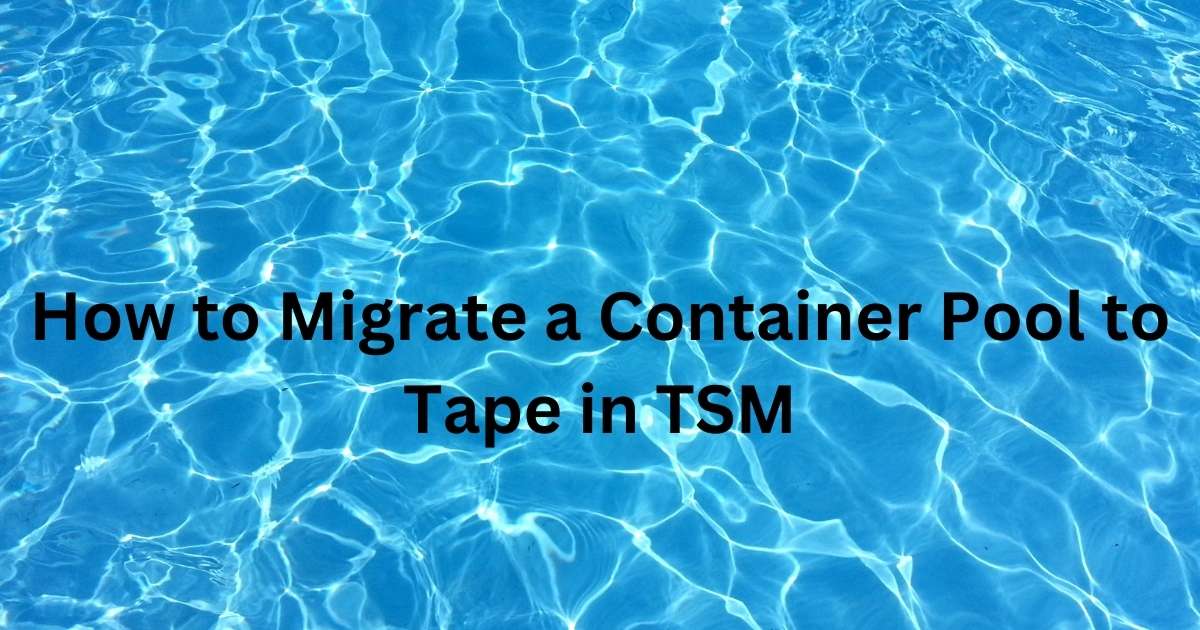Migrating a container pool to tape in Tivoli Storage Manager (TSM) can seem like a daunting task. However, with the right process, it’s a manageable and efficient solution for long-term data storage. This guide dives deep into the step-by-step process, offering practical insights for a smooth migration.
Understanding the Need for Migration
Migration of a container pool to tape in TSM is typically done for cost-saving or data archival reasons. Tape storage offers a more economical solution for storing infrequently accessed data compared to disk-based container pools.
Preparation Before Migration
Before starting the migration process, ensure you have adequate resources and a comprehensive understanding of your TSM environment. Key preparatory steps include:
- Assessing Data Volume: Determine the size of the data in the container pool.
- Tape Infrastructure Readiness: Verify that tape drives and libraries are operational.
- Backup Verification: Ensure that all data is backed up to avoid potential loss during migration.
Advantages of Migrating a Container Pool to Tape
Migrating a container pool to tape in TSM brings multiple benefits:
- Cost-Efficiency: Tape is significantly cheaper for storing large volumes of data.
- Long-Term Storage: Tapes provide durable storage for archival purposes.
- Scalability: Expanding tape storage is easier and more affordable.
Key Tools and Commands in TSM
Understanding TSM’s commands is essential for a successful migration. Some frequently used commands include:
MOVE CONTAINER: Moves data from a container pool.DEFINE STGPOOL: Defines a new storage pool for the tape.QUERY PROCESS: Monitors ongoing processes during migration.
Step-by-Step Migration Process
Step 1: Verify the Current Environment
Before migration, check the status of your container pool using the QUERY STGPOOL command. This ensures you have a clear picture of the data and available resources.
Step 2: Define a Tape Storage Pool
Create a new storage pool for the tape using the DEFINE STGPOOL command. Specify parameters like retention policies and access modes.
Step 3: Configure Tape Devices
Ensure that tape drives and libraries are configured properly in TSM. Use the DEFINE DEVCLASS command to define the device class for the tape.
Step 4: Initiate Data Movement
Use the MOVE CONTAINER command to start the migration process. This command transfers data from the container pool to the defined tape storage pool.
Step 5: Monitor the Process
Monitor the migration using the QUERY PROCESS command. This helps track the progress and troubleshoot any issues that arise.
Step 6: Verify Data Integrity
After the migration is complete, validate data integrity by checking for errors or missing files. This ensures that all data has been successfully moved.
Challenges During Migration
Performance Bottlenecks
The migration process can slow down if the tape drives or the TSM server is overloaded. Ensure optimal load distribution to avoid delays.
Data Errors
Occasionally, data might fail to transfer correctly. Regularly check logs to identify and address any errors promptly.
Best Practices for Migration
- Plan During Off-Peak Hours: Perform migration during periods of low server activity to minimize disruptions.
- Use Incremental Transfers: Break the migration into smaller chunks for better efficiency and error handling.
- Maintain a Log: Keep detailed records of the migration process for troubleshooting and auditing purposes.
Post-Migration Steps
Update Policies
After migration, update retention and access policies to align with the new tape storage system.
Test Restores
Conduct test restores to ensure data can be retrieved seamlessly from the tape storage.
Archive Verification
Periodically verify tape archives to confirm long-term data integrity.
Benefits of a Successful Migration
Migrating a container pool to tape in TSM provides a reliable and cost-effective way to manage data. A properly executed migration improves storage efficiency, ensures data safety, and offers flexibility for scaling storage needs.
Conclusion
Migrating a container pool to tape in TSM requires careful planning and execution. By following the steps outlined above, you can ensure a smooth and efficient migration process. Tapes remain an excellent solution for long-term data storage, offering both reliability and cost savings.
FAQs
Q1: How long does the migration process take?
The time depends on the volume of data and the performance of your tape drives. Typically, larger datasets require more time.
Q2: Can I pause the migration process?
Yes, TSM allows you to pause and resume the migration process using appropriate commands.
Q3: Is tape storage still relevant today?
Absolutely! Tape storage is cost-effective and reliable, especially for archival and infrequently accessed data.
Q4: What happens if an error occurs during migration?
Errors can be addressed by reviewing the TSM logs. You may need to reinitiate the migration for the affected data.
Q5: How do I check the status of the migration?
Use the QUERY PROCESS command in TSM to monitor the progress and status of the migration.



